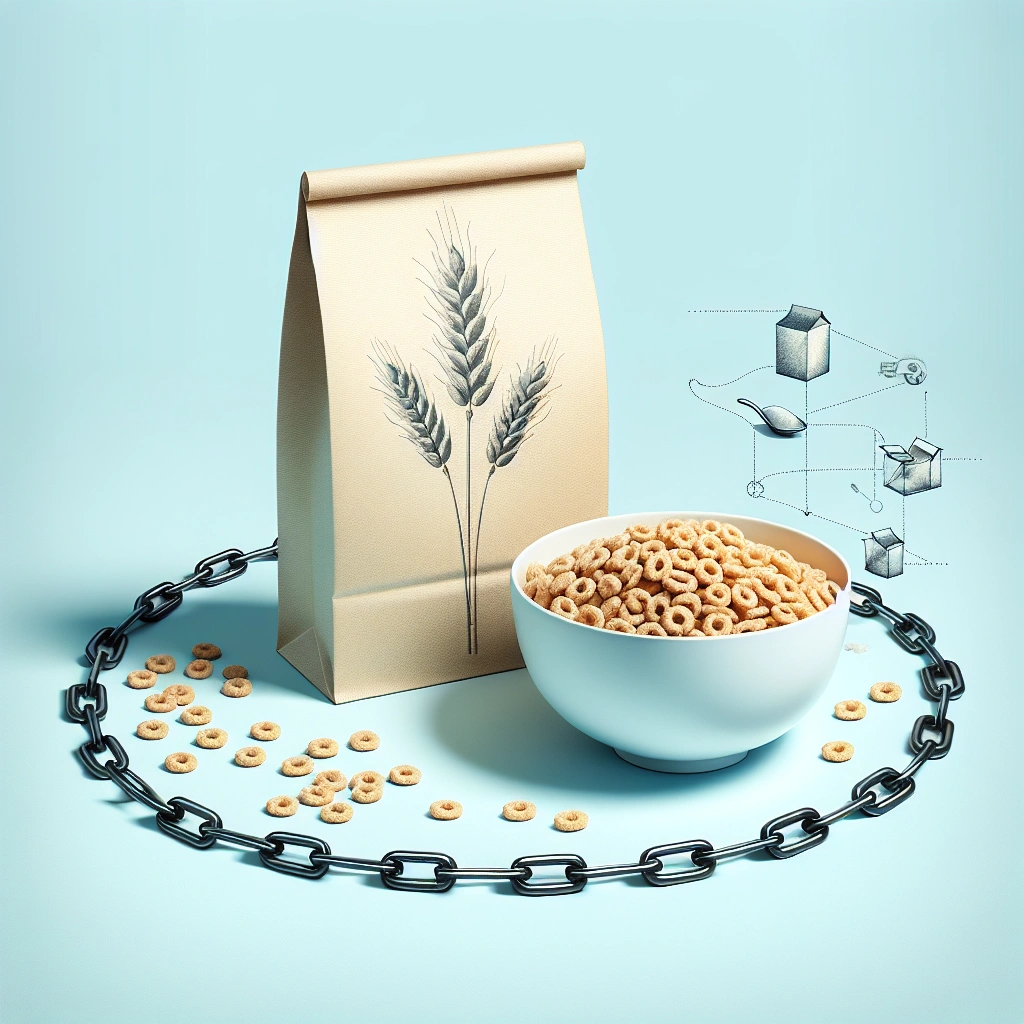Short Answer for: What Happened to Fiber One Cereal?
Supply chain disruptions, the Fiber One cereal shortage resulted from supply chain disruptions, product recalls related to safety concerns, and increased demand, with General Mills promising normal stock levels by October 2023.
Imagine starting your day, eager for that wholesome bowl of Fiber One cereal, only to find the shelves unexpectedly bare. This isn’t just about missing your favorite high-fiber start to the day; it’s a peek into a larger saga of supply chain disruptions, product recalls, and a global pandemic effect that has rattled our access to even the simplest of joys-our breakfast. What happened to Fiber One cereal is a story that mirrors the unpredictable nature of our times, inviting you to delve deeper into the ripples it has created in the lives of many, much like your own.
-
Uncover the intriguing fate of a breakfast favorite in “Fiber One Cereal The Aftermath!” – a must-watch for anyone interested in the lifestyle impacts of food choices and how they correlate with current trends in men’s health and grooming. Check out this Youtube video:
The Fiber One cereal shortage was caused by a combination of supply chain disruptions, product recalls, and increased demand.
-
A significant recall was initiated due to the discovery of metal in over 300,000 cereal and snack packages, impacting availability and consumer trust.
-
General Mills acknowledged the shortage, attributing it to supply issues but reassured that the cereal was not discontinued, anticipating a return to normal stock levels by October 2023.
-
Additional strain on the cereal supply chain was caused by a recall from Quaker Oats over a salmonella scare and broader challenges such as the COVID-19 pandemic and Kellogg employee strike.
-
Speculation and frustration among consumers were evident on forums like Reddit, with some suspecting inventory manipulation for profit reasons.

Product Description and Consumer Statements on Fiber One’s Benefits
Fiber One’s Original Bran Breakfast Cereal is renowned for its high dietary fiber content and nutritional benefits, including 102% of the Daily Value of fiber per serving, with no added sugars and low calories. Consumers report significant health improvements such as stabilized blood sugar levels, enhanced cholesterol health, and better digestion, thanks to its rich fiber content from whole grains. This cereal is celebrated not only as a healthy breakfast choice but also for its versatility in recipes, making it a preferred option for those seeking a fiber-rich diet that doesn’t compromise on taste or nutritional value.
Offering a detailed overview of Fiber One cereal
Fiber One’s Original Bran Breakfast Cereal is not just a regular breakfast option. It stands out with its impressive dietary fiber content, aimed at those looking to increase their daily fiber intake. Each serving delivers a substantial dose of fiber, with one serving containing 90 calories and no added sugars, keeping it low in calories yet high in nutritional value. The detailed nutrition breakdown highlights 0g of saturated fats, remarkably low sodium at 140mg (6% DV), and a substantial 33g of total carbohydrates, of which dietary fiber is a significant component.
This cereal’s formulation is designed with health in mind, providing 102% of the Daily Value of fiber as noted in cerealsecrets.com’s analysis, which also mentions its beneficial contributions to calcium and iron intake, marking it as an excellent source of several essential nutrients. Its original no added sugar variety seeks to offer individuals a health-conscious option without compromising on taste.
Highlighting the consumer-reported advantages of incorporating Fiber One into their diet
Consumers have widely reported a range of health benefits upon incorporating Fiber One cereal into their regular diet. The high fiber content, for example, is often credited with helping maintain consistent blood sugar levels, an advantage supported by insights from registered dietitian Samina Qureshi. She points out that fiber-rich cereals such as Fiber One can stabilize blood sugar levels, boost cholesterol health, and assist in maintaining regular bowel movements by adding bulk to stool.
These health benefits align with Harvard Health Blog’s advocacy for cereal fiber from whole grains as a strategic choice for protecting against conditions such as heart disease and diabetes. Moreover, consuming Fiber One as part of a balanced diet contributes to reduced risks of obesity and overweight, as indicated by a systematic review in PMC articles detailing the health benefits of dietary fiber.
Beyond the obvious health perks, users report enjoying the versatility of Fiber One cereal. It serves not only as a hearty breakfast choice but also as a satisfying ingredient in recipes or as a standalone snack.
Its blend of whole grain wheat, corn bran, and other quality ingredients delivers a taste that is both gratifying and guilt-free.
Dietitian recommendations for high-fiber cereal foods rank products like Fiber One high on the list for their exceptional nutritional profile and contribution to a balanced diet. Such endorsements underscore the cereal’s standing as a top choice among health-conscious consumers seeking delicious, fiber-rich foods that support overall well-being.
Fiber One’s combination of high dietary fiber, minimal added sugars, and essential nutrients offers a compelling option for anyone looking to enhance their dietary intake. Consumer testimonials affirm the cereal’s effectiveness in promoting digestive health, supporting weight management, and offering a nourishing start to the day, making it a comprehensive dietary choice for health-aware individuals.

What happened to Fiber One cereal?
The Fiber One cereal shortage was precipitated by a series of interconnected issues, including substantial product recalls due to safety concerns such as metal fragments, supply chain disruptions exacerbated by the COVID-19 pandemic, and heightened market demand for cereal products. General Mills, the manufacturer of Fiber One, acknowledged the shortage and attributed it mainly to supply issues, promising a resolution and return to normal stock levels by October 2023. This situation, coupled with recalls from other cereal companies like Quaker Oats and a three-month-long Kellogg employee strike, has contributed to the broader cereal shortage, leaving consumers anxious for the return of their favorite high-fiber breakfast option.
Identifying the core reasons behind the Fiber One cereal shortage
The sudden shortage of Fiber One cereal can be traced back to a combination of supply chain disruptions, product recalls, and increased demand. These events have created a perfect storm, leading to the disappearance of this favorite high-fiber breakfast option from many store shelves.
Firstly, the issues began with wholesale recalls. For example, a significant recall affected over 300,000 cereal and snack packages due to the discovery of metal in products, impacting consumer trust and leading to shortages.
The situation was further exacerbated by the Fiber One Shortage of 2024, where General Mills, the manufacturer, acknowledged the shortage but reassured consumers that the cereal was not discontinued. They cited supply issues but promised a return to normal stock levels by October 2023, as also confirmed by news from today.com.
Compounding the shortage, Quaker Oats, another major player in the cereal market, issued a recall for granola bars, cereals, and more due to a salmonella scare, further straining the cereal supply chain.
The broader context includes challenges like the COVID-19 pandemic’s impact on economic growth and cereal demand, as elucidated in the OECD-FAO Agricultural Outlook 2020-2029, and food insecurity in Africa due to various factors including high population growth rates and low rural incomes, discussed in an article by MDPI.
Moreover, the overall cereal industry experienced shortages throughout 2021 due to supply chain disruptions and a three-month-long Kellogg employee strike, raising concerns about an ongoing cereal shortage which Tasting Table suggested might be coming to an end.
Finally, speculation on forums like Reddit about possible inventory manipulation by General Mills for profit reasons indicates consumer suspicion and frustration, as seen in the discussion on why Fiber one 65% fiber Cereal was out of stock.
The Fiber One cereal shortage is a multifaceted issue, encompassing safety recalls, supply chain problems, and global economic impacts. These factors combined have disrupted the availability of this dietary staple, leaving consumers wondering when their beloved high-fiber breakfast option will return to shelves.

Fiber One Cereal Shortage: Ingredients and Supply Chain Insights
The Fiber One cereal shortage is primarily driven by constrained availability of essential ingredients such as whole grain wheat, corn bran, and modified wheat starch, alongside broader supply chain disruptions exacerbated by the COVID-19 pandemic. Factors like extreme weather conditions, import-export restrictions, and increased demand for nutritious components, compounded by farm labor shortages, processing delays, and transportation bottlenecks have significantly impacted the production lines of Fiber One cereal. Addressing these shortages effectively requires tackling both direct sourcing issues of crucial ingredients and strengthening the resilience of global supply chains, as highlighted by insights from the OECD, MDPI, NCBI, and WEF.
Examining the impact of ingredients availability on Fiber One production
One of the primary reasons behind the Fiber One cereal shortage is the constrained availability of key ingredients. The robust blend of whole grain wheat, corn bran, and modified wheat starch, as detailed on General Mill’s product page, faced supply chain challenges. Factors such as extreme weather conditions, import-export restrictions, and increased demand for these nutritious components have tightened the supply, reflecting on Fiber One’s production lines. The cereal, celebrated for its high fiber content, mainly relies on these ingredients to deliver its promise of aiding a healthy diet, making their availability crucial for the cereal’s production.
Analyzing the supply chain dynamics contributing to the cereal’s scarcity
The Fiber One cereal shortage can also be attributed to broader supply chain dynamics, exacerbated by the COVID-19 pandemic. Disruptions have been seen across various stages of the supply chain, including farm labor shortages, processing delays, and transportation bottlenecks. Reports from OECD, MDPI, and NCBI highlight how the pandemic has introduced unprecedented stresses to food supply chains globally, affecting the availability of ingredients and finished products alike. Moreover, insights from WEF emphasize the fragility of global supply chains, underlining the cascading effect of closures and bottlenecks on consumer goods, including Fiber One cereal. Companies, including General Mills, have acknowledged these challenges, with supply issues impacting their capacity to meet consumer demand for Fiber One cereals.
The interplay between the availability of specific ingredients crucial for Fiber One cereal and the broader supply chain disruptions come together to paint a picture of why shortages have occurred. Moving forward, resolving these shortages will likely require a multifaceted approach, addressing both direct ingredient sourcing issues and the wider supply chain vulnerabilities exposed by the pandemic.

Alternatives to Fiber One Cereal During the Shortage
During the shortage of Fiber One cereal, many enthusiasts are looking for suitable substitutes that maintain a high fiber content and offer ease of preparation, without compromising on taste. Locating an alternative can be straightforward if one knows where to look and what to look for in terms of nutritional facts.
Listing suitable cereal substitutes for Fiber One enthusiasts
For a delightful start to the day that doesn’t fall short on the fiber front, Kellogg’s All-Bran comes as a prime choice. This cereal is not only tasty but loaded with essential nutrients (Consumer Reports). Another commendable option is Kashi GOLEAN Original, a blend that combines taste with texture and a generous fiber content, proving that dietary fiber and deliciousness can go hand in hand (The Balanced Nutritionist).
Cascadian Farm Organic Hearty Morning Fiber Cereal is slightly sweet and packed with whole grain flakes and bran sticks, making it a superb choice for those seeking a hearty bowl of cereal. Post Great Grains Cereal, with its crunchy pecan variant, provides a unique flavor and textural experience, making it a noteworthy recommendation for high-fiber seekers.
Grape Nuts Original Breakfast Cereal is an evergreen choice, cherished for its simplistic yet wholesome ingredient list. This option might be appealing for those who appreciate a no-frills approach to boosting their fiber intake.
Comparative analysis of alternatives based on nutrition facts and preparation ease
When comparing these alternatives based on their nutritional facts and preparation ease, there are few important aspects to consider:
| Cereal Name | Fiber Content Per Serving | Calories | Easy to Prepare | Additional Nutritional Benefits |
|---|---|---|---|---|
| Kellogg’s All-Bran | High | Low | Yes | Rich in iron and calcium |
| Kashi GOLEAN Original | High | Moderate | Yes | Contains antioxidants, vitamins, and minerals |
| Cascadian Farm Organic Hearty Morning Fiber Cereal | High | Moderate | Yes | Organic, Non-GMO |
| Post Great Grains Cereal, Crunchy Pecan | Moderate | Moderate | Yes | Contains nuts for added protein and healthy fats |
| Grape Nuts Original Breakfast Cereal | High | Low | Yes | Simple ingredients, rich in malted barley flour, a unique source of nutrition |
Regarding preparation ease, all listed cereals share the common benefit of being quick to prepare, making them excellent choices for individuals with a busy lifestyle. However, their nutritional profiles vary, with some providing higher calorie counts or added nutritional benefits, such as antioxidants or organic ingredients.
While the shortage of Fiber One cereal might have caught many off guard, it opens the door to exploring other nutritious and fiber-rich cereals. From the simplicity and crunchy goodness of Grape Nuts to the delightful complexity of Cascadian Farm Organic Hearty Morning Fiber Cereal, there is a plethora of options available to satisfy both taste preferences and dietary needs.
Whether you’re in pursuit of an organic option or something loaded with additional vitamins and minerals, the array of alternatives ensures that your high-fiber diet remains on track, delicious, and varied.

Conclusion
The Fiber One cereal shortage resulted from a mix of supply chain disruptions, product recalls, and an increased demand. Key ingredients faced shortages due to extreme weather, export-import restrictions, and a higher demand, impacting production. Moreover, the COVID-19 pandemic exacerbated supply chain challenges at every level, from farming to distribution.
Efforts to resolve the shortage will require addressing both the availability of these crucial ingredients and the broader supply chain vulnerabilities. General Mills has recognized the issue and promised a return to normal stock levels by personalizing the approach to tackle direct sourcing and wider supply logistics.
During this shortage, consumers have turned to alternatives like Kellogg’s All-Bran and Kashi GOLEAN Original, among others, seeking to replicate the high fiber content and nutritional benefits of Fiber One. These substitutes offer a temporary solution until Fiber One can fully resume its position on store shelves, underlining the importance of dietary fiber in many individuals’ diets.
